headlamp CADILLAC DEVILLE 1996 7.G Owners Manual
[x] Cancel search | Manufacturer: CADILLAC, Model Year: 1996, Model line: DEVILLE, Model: CADILLAC DEVILLE 1996 7.GPages: 354, PDF Size: 20.32 MB
Page 73 of 354
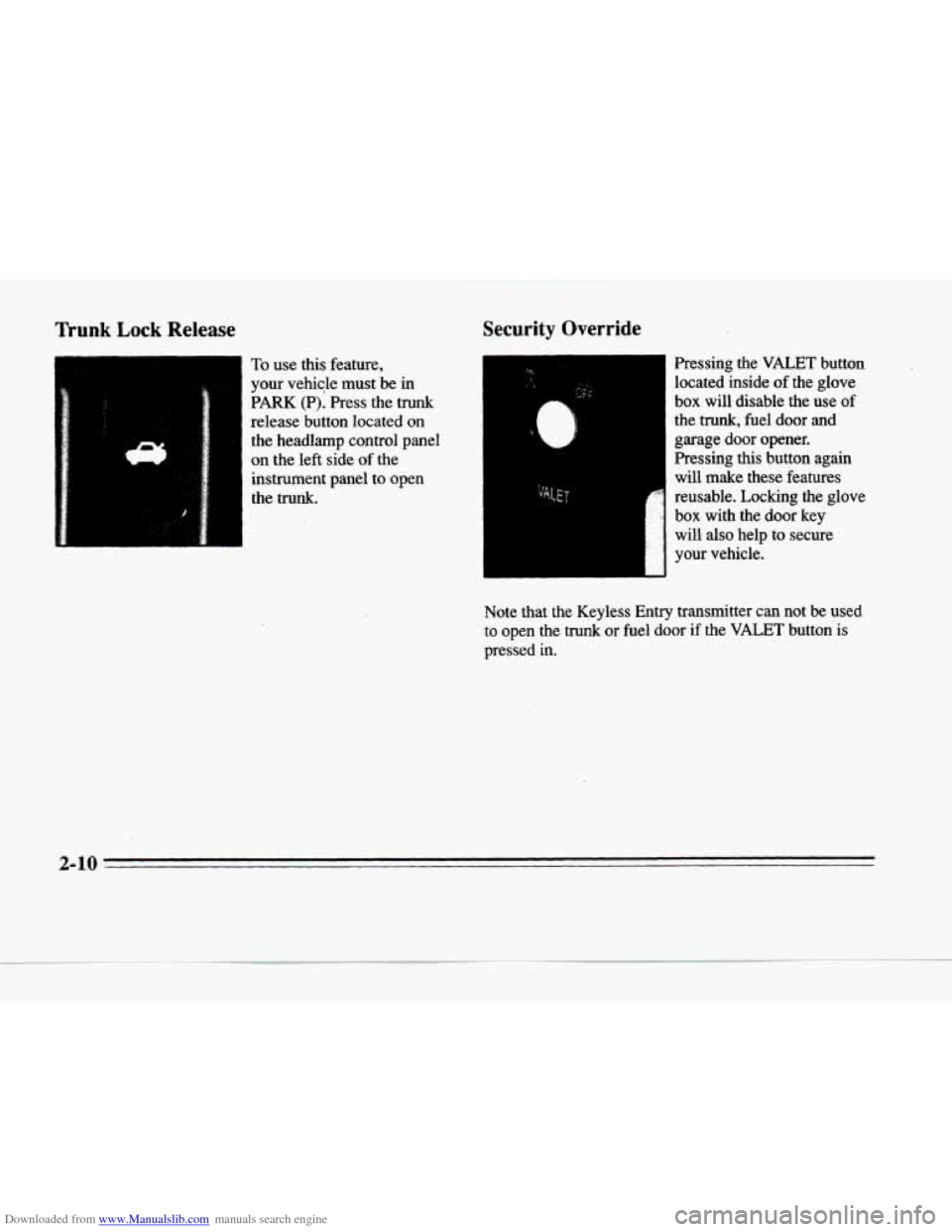
Downloaded from www.Manualslib.com manuals search engine Trunk Lock Release
To use this feature,
your vehicle must
be in
PARK (P). Press the trunk
release button located on
the headlamp control panel
on the left side of the
instrument panel to open
the trunk.
Security Override
....
Pressing the VALET button
located inside
of the glove
box will disable the use
of
the trunk, fuel door and
garage door opener.
Pressing this button again
I will make these features
i reusable. Locking the glove
box with the door key
I will also help to secure
~ your vehicle.
Note that the Keyless Entry transmitter can not be used
to open the trunk or fuel door if the VALET button is
pressed in.
2-10
--.
CI
Page 76 of 354
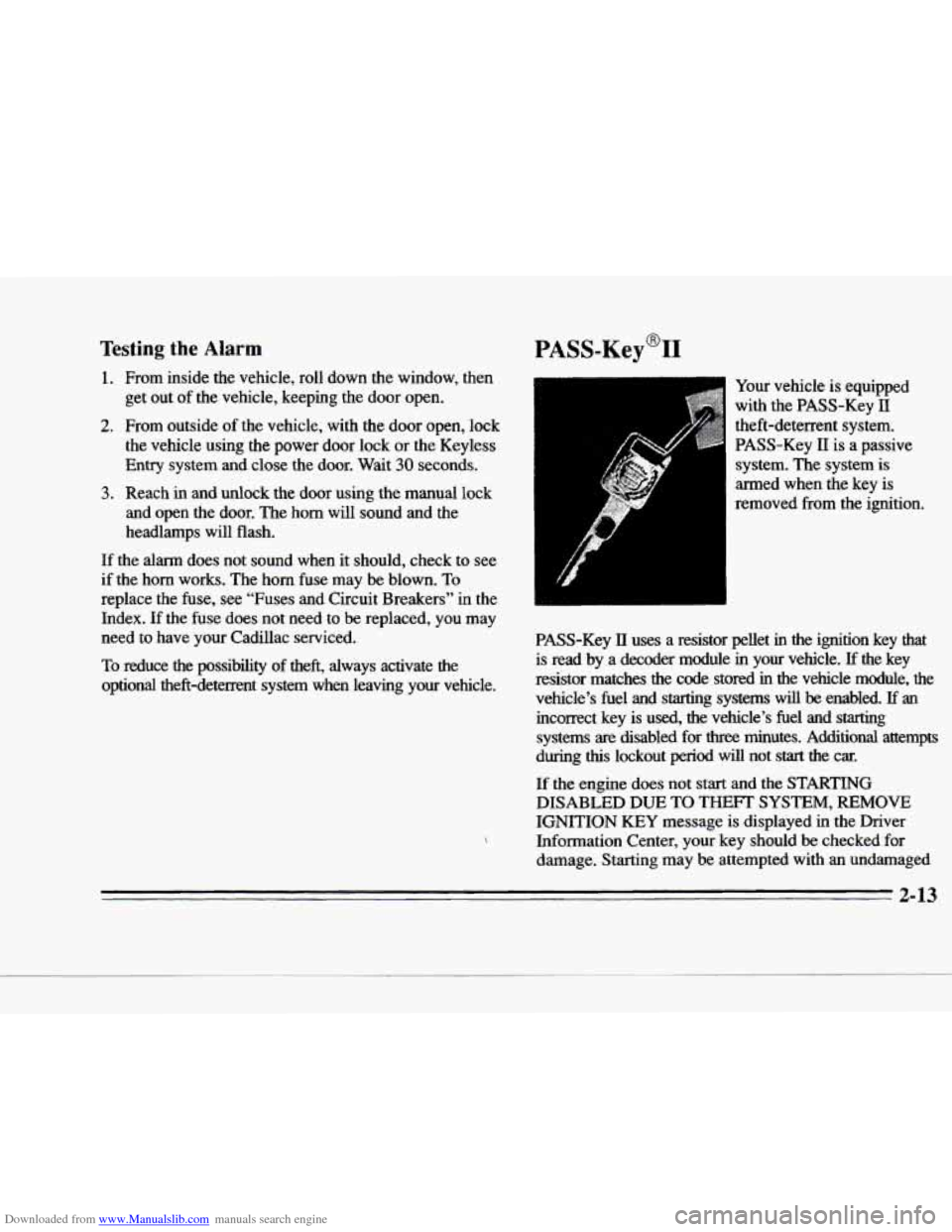
Downloaded from www.Manualslib.com manuals search engine r-
c
Testing the Alarm
1. From inside the vehicle, roll down the window, then
get
out of the vehicle, keeping the door open.
2. From outside of the vehicle, with the door open, lock
the vehicle using the power door lock or
the Keyless
Entry system
and close the door. Wait 30 seconds.
3. Reach in and unlock the door using the manual lock
and open the door. The horn will sound and the
headlamps will flash.
If the alm does not sound when it should, check to see
if the horn works. The horn fuse may be blown. To
replace the fuse, see “Fuses and Circuit Breakers” in the\
Index.
If the fuse does not need to be replaced, you may
need to have your Cadillac serviced.
To reduce the possibility of theft, always activate the
optional theft-deterrent system when leaving your vehicle.
PASS-Key%
I Your vehicle is equipped
with the PASS-Key
I1
theft-deterrent system. PASS-Key
I1 is a passive
system. The system is
armed when the key is
removed from the ignition.
PASS-Key
11 uses a resistor pellet in the ignition key that
is read by a decoder module-in your vehicle. If the key
resistor matches the code stored
in the vehicle module, the
vehicle’s fuel and starting systems will
be enabled. If an
incorrect key is used, the vehicle’s fuel and starting
systems are disabled for three minutes. Additional attempts
during
this lockout period will not start the car.
If the engine does not start and the STARTING
DISABLED DUE TO THEFT SYSTEM, REMOVE
IGNITION KEY message is displayed in the Driver
Information Center, your
key should be checked for
damage.
Starting may be attempted with an undamaged
2-13
Page 95 of 354
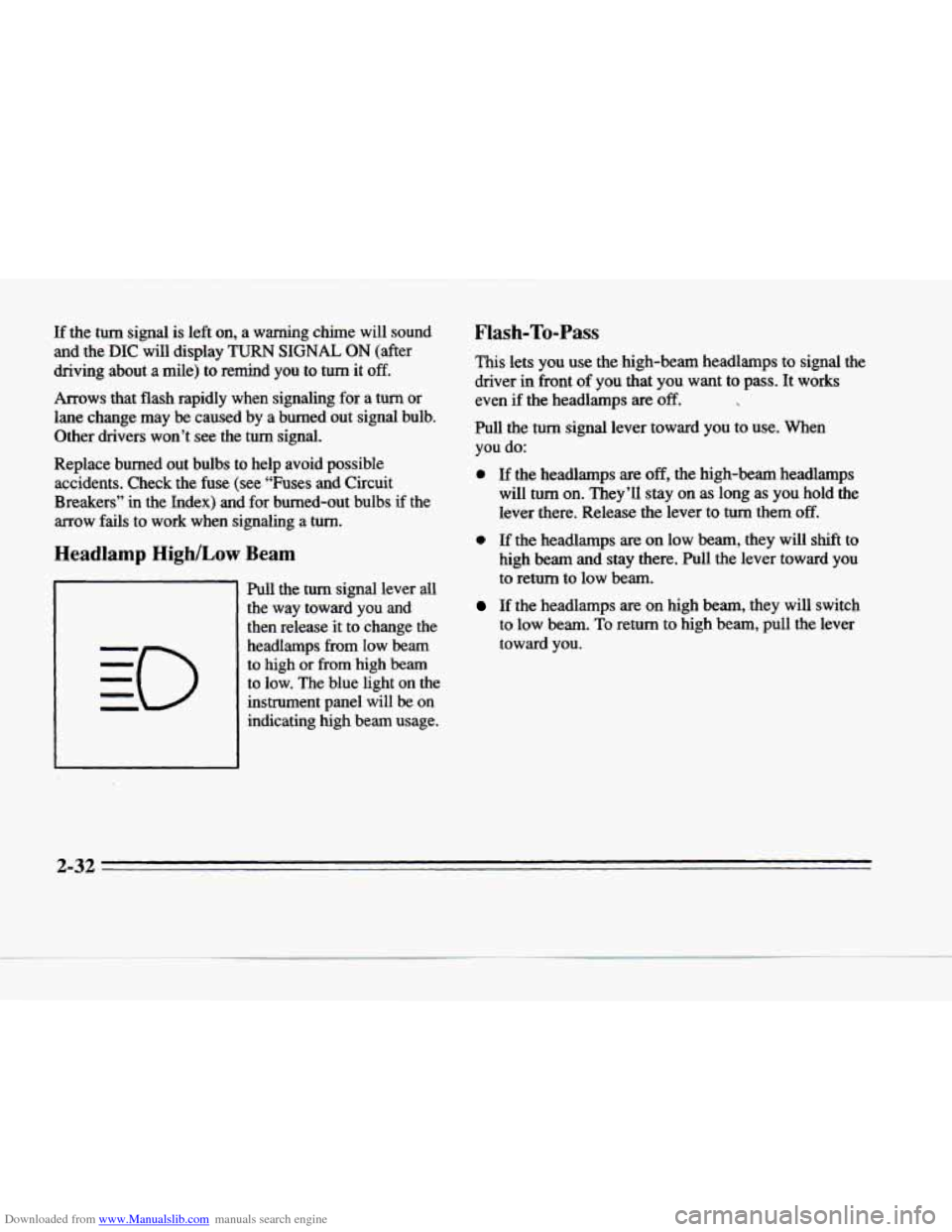
Downloaded from www.Manualslib.com manuals search engine If the turn signal is left on, a warning chime will sound
and the DIC
will display TURN SIGNAL ON (after
driving about
a mile) to remind you to turn it off.
Arrows that flash rapidly when signaling for a turn or
lane change may
be caused by a burned out signal bulb.
Other drivers won’t see the turn signal.
Replace burned out bulbs to help avoid possible accidents. Check the fuse (see “Fuses and Circuit
Breakers”
in the Index) and for burned-out bulbs if the
arrow fails to work when signaling a turn.
Headlamp High/Low Beam
Pull the turn signal lever all
the way toward you and then release
it to change the
headlamps
from low beam
to high
or from high beam
to low. The blue light on the
instrument panel will
be on
indicating high beam usage.
Flash-To-Pass
This lets you use the high-beam headlamps to signal the
driver in front
of you that you want to pass. It works
even
if the headlamps are ‘off.
Pull the turn signal lever toward you to use. When
you do:
0 If the headlamps are off, the high-beam headlamps
will turn
on. They’I1 stay on as long as you hold the
lever there. Release the lever to turn them
off.
0 If the headlamps are on low beam, they will shift to
high
beam and stay there. Pull the lever toward you
to return to low beam.
If the headlamps are on high beam, they will switch
to low beam. To return to high beam, pull the lever
toward you.
2-32
Page 103 of 354
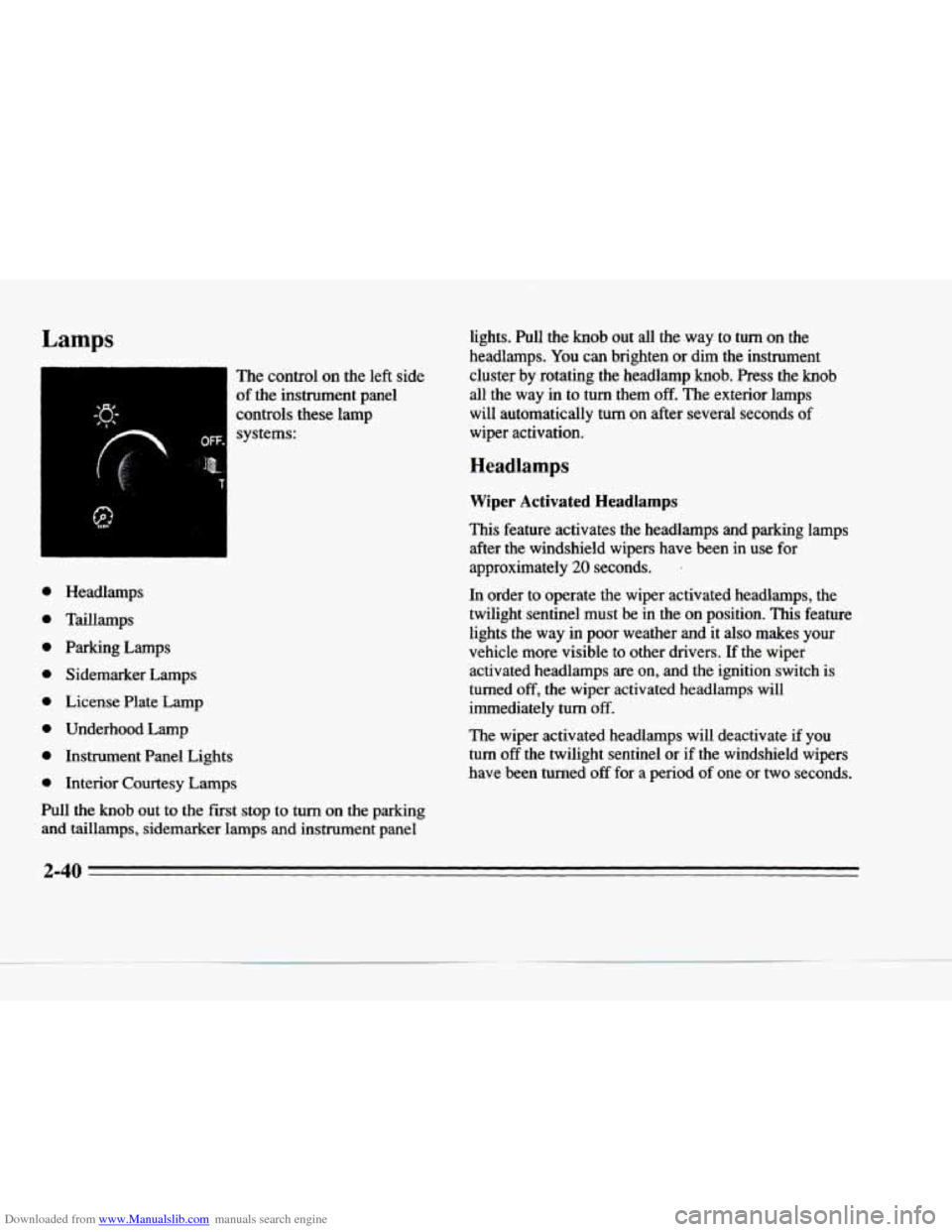
Downloaded from www.Manualslib.com manuals search engine Lamps
1
The control on the left side
of the instrument panel
controls these lamp systems:
e
e
e
e
e
e
e
e
Headlamps
Taillamps
Parking Lamps Sidemarker Lamps
License Plate Lamp
Underhood Lamp
Instrument Panel Lights
Interior Courtesy Lamps
Pull the knob out to the
fist stop to turn on the parking
and taillamps, sidemarker lamps and instrument panel lights. Pull the
knob out all the way to turn on the
headlamps.
You can brighten or dim the instrument
cluster by rotating the headlamp
knob. Press the knob
all the way in to turn them off. The exterior lamps
will automatically turn
on after several seconds of
wiper activation.
Headlamps
Wiper Activated Headlamps
This feature activates the headlamps and parking lamps after the windshield wipers have been in
use for
approximately 20 seconds. ’
In order to operate the wiper activated headlamps, the
twilight sentinel must
be in the on position. This feature
lights the way
in poor weather and it also makes your
vehicle more visible to other drivers. If the wiper activated headlamps are
on, and the ignition switch is
turned
off, the wiper activated headlamps will
immediately
turn off.
The wiper activated headlamps will deactivate
if you
turn off the twilight sentinel or if the windshield wipers
have been turned
off for a period of one or two seconds.
2-40
Page 104 of 354
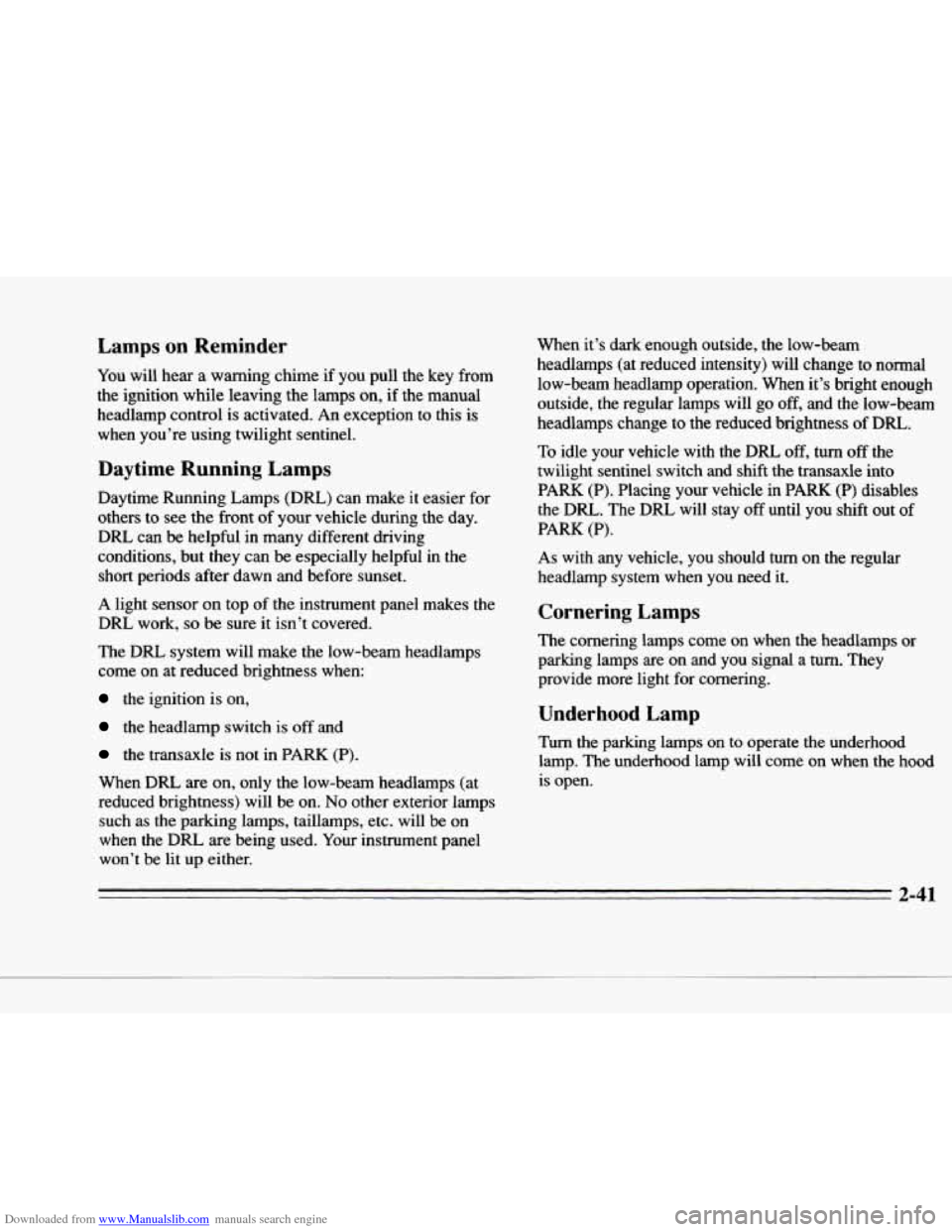
Downloaded from www.Manualslib.com manuals search engine P
c
21
c
P
c
Lamps on Reminder
You will hear a warning chime if you pull the key from
the ignition while leaving the lamps
on, if the manual
headlamp control is activated. An exception to this is
when you’re using twilight sentinel.
Daytime Running Lamps
Daytime Running Lamps (DRL) can make it easier for
others to see the front of your vehicle during
the day.
DRL can be helpful
in many different driving
conditions, but they can be especially helpful in
the
short periods after dawn and before sunset.
A light sensor on top of the instrument panel makes the
DRL work,
so be sure it isn’t covered.
The
DRL system will make the low-beam headlamps
come
on at reduced brightness when:
the ignition is on,
the headlamp switch is off and
the transaxle is not in PARK (P).
When DRL are on, only the low-beam headlamps (at
reduced brightness) will be
on. No other exterior lamps
such as the parking lamps, taillamps, etc. will be on
when the
DRL are being used. Your instrument panel
won’t be
lit up either. When
it’s dark enough outside, the low-beam
headlamps (at reduced intensity) will change
to normal
low-beam headlamp operation. When it’s bright enough
outside, the regular lamps will go
off, and the low-beam
headlamps change to the reduced brightness
of DRL.
To idle your vehicle with the DRL off, tum off the
twilight sentinel switch and shift the transaxle into
PARK (P). Placing your vehicle in PARK (P) disables
the DRL. The DRL will stay
off until you shift out of
PARK (P).
As with any vehicle, you should turn on the regular
headlamp system when you need it.
Cornering Lamps
The cornering lamps come on when the headlamps or
parking lamps are on and you signal a turn. They
provide more light for cornering.
Underhood Lamp
Turn the parking lamps on to operate the underhood lamp. The underhood
lamp will come on when the hood
is open.
2-41
Page 106 of 354
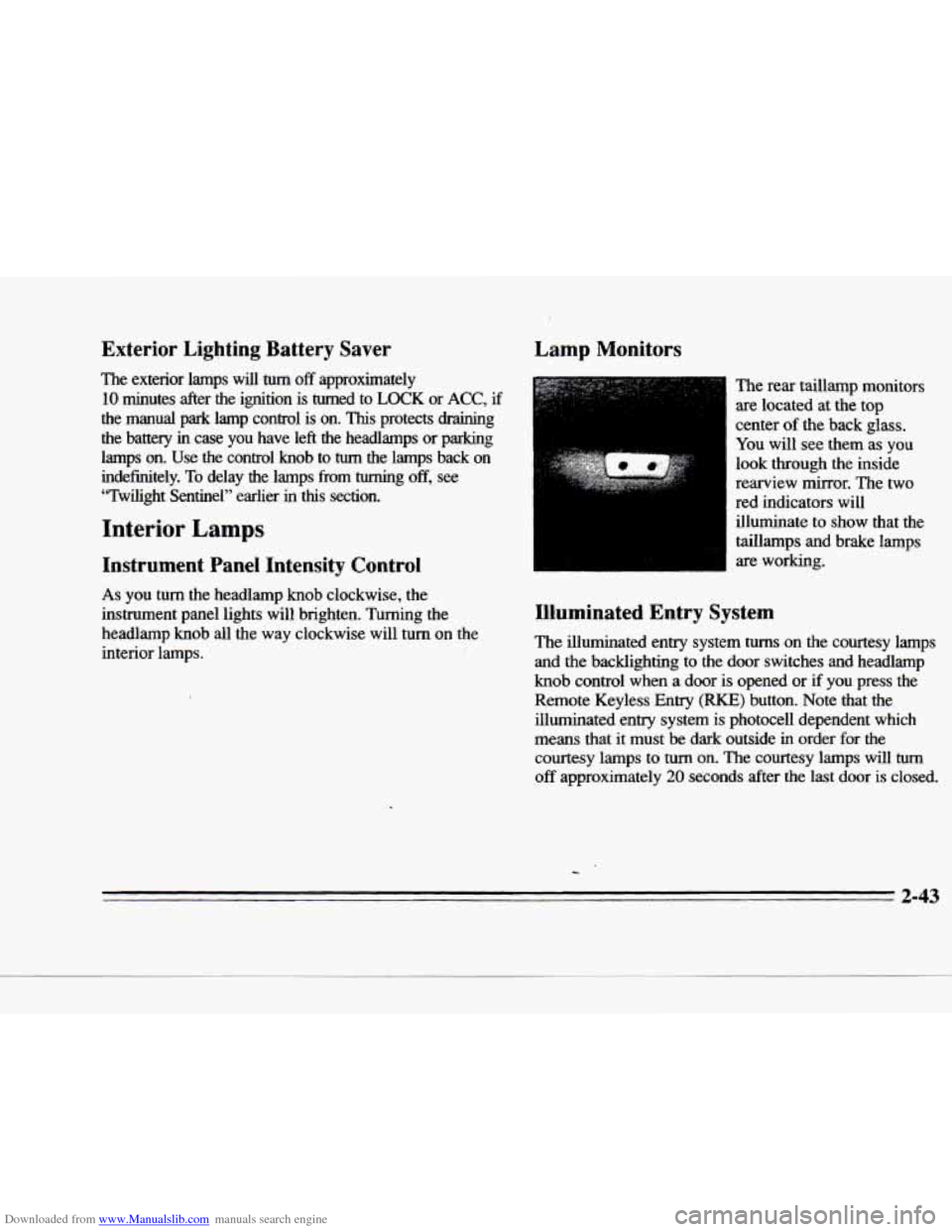
Downloaded from www.Manualslib.com manuals search engine c
c-
Exterior Lighting Battery Saver
The exterior lamps will turn off approximately
10 minutes after the ignition is turned to LOCK or ACC, if
the manual park lamp control is on. This protects draining
the battery
in case you have left the headlamps or parking
lamps on. Use the control knob to
turn the lamps back on
indefinitely. To delay the lamps from tuming off, see
"Twilight Sentinel" earlier in this section.
Interior Lamps
Instrument Panel Intensity Control
As you turn the headlamp knob clockwise, the
instrument panel lights will brighten. Turning the
headlamp knob all the way clockwise will turn on the interior lamps.
Lamp Monitors
The rear taillamp monitors
are located at the top
center
of the back glass.
You will see them as you
look through the inside
rearview mirror. The two
red indicators will
illuminate to show that the
taillamps and brake lamps
are working.
Illuminated Entry System
The illuminated entry system turns on the courtesy lamps
and the backlighting
to the door switches and headlamp
knob control when a door is opened or if you press the
Remote Keyless Entry
(RKE) button. Note that the
illuminated entry system
is photocell dependent which
means that it must
be dark outside in order for the
courtesy lamps to
turn on. The courtesy lamps will turn
off approximately 20 seconds after the last door is closed.
2-43
Page 109 of 354
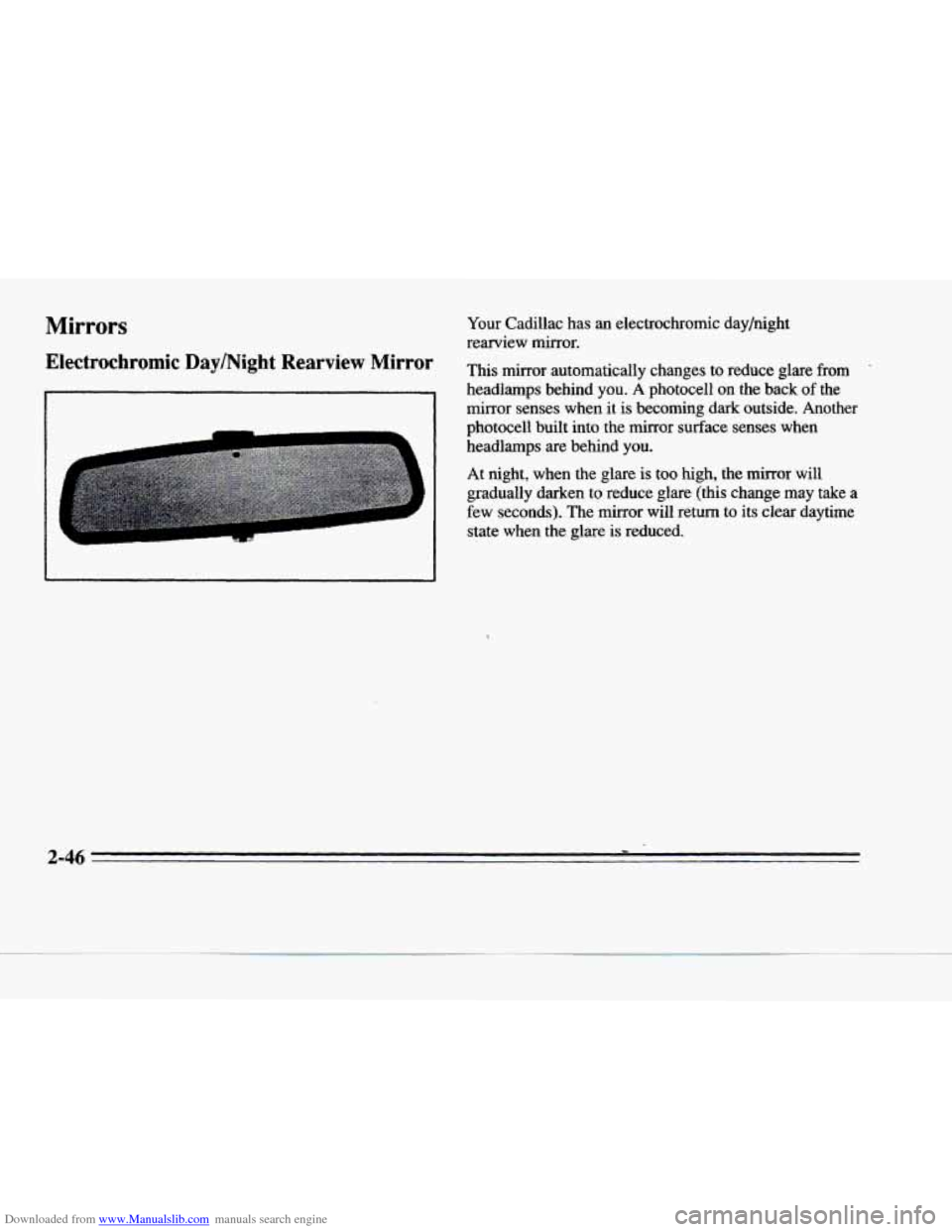
Downloaded from www.Manualslib.com manuals search engine Mirrors
Electrochromic DaylNight Rearview Mirror
Your Cadillac has an electrochromic day/night
rearview mirror.
This mirror automatically changes to reduce glare
from '
headlamps behind you. A photocell on the back of the
mirror senses when it is becoming dark outside. Another
photocell built into the mirror surface senses when
headlamps are behind you.
At night, when the glare is too high, the mirror will
gradually darken
to reduce glare (this change may take a
few seconds). The
mirror will return to its clear daytime
state when the glare is reduced.
3
4
3
Page 111 of 354
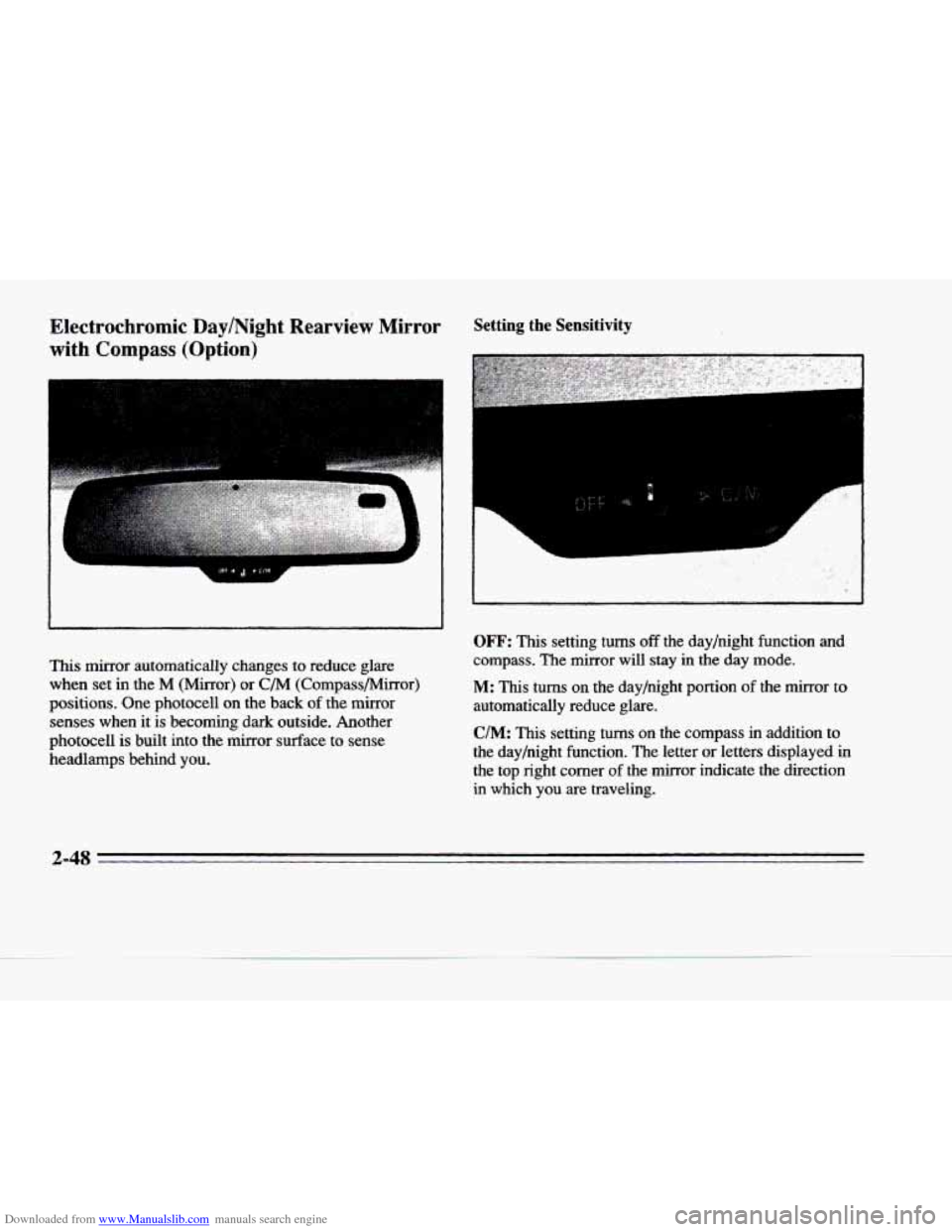
Downloaded from www.Manualslib.com manuals search engine Electrochromic Day/Night Rearview Mirror
with
Compass (Option)
L
1
This mirror automatically changes to reduce glare
when set in the
M (Mirror) or C/M (Compass/Mirror)
positions. One photocell
on the back of the mirror
senses
when it is becoming dark outside. Another
photocell
is built into the mirror surface to sense
headlamps behind
you.
Setting the Sensitivity
r
OFF: This setting turns off the day/night function and
compass.
The mirror will stay in the day mode.
M: This turns on the day/night portion of the mirror to
automatically reduce glare.
C/M: This setting turns on the compass in addition to
the day/night function. The letter or letters displayed in
the top right comer
of the mirror indicate the direction
in which you are traveling.
2-48
Page 114 of 354
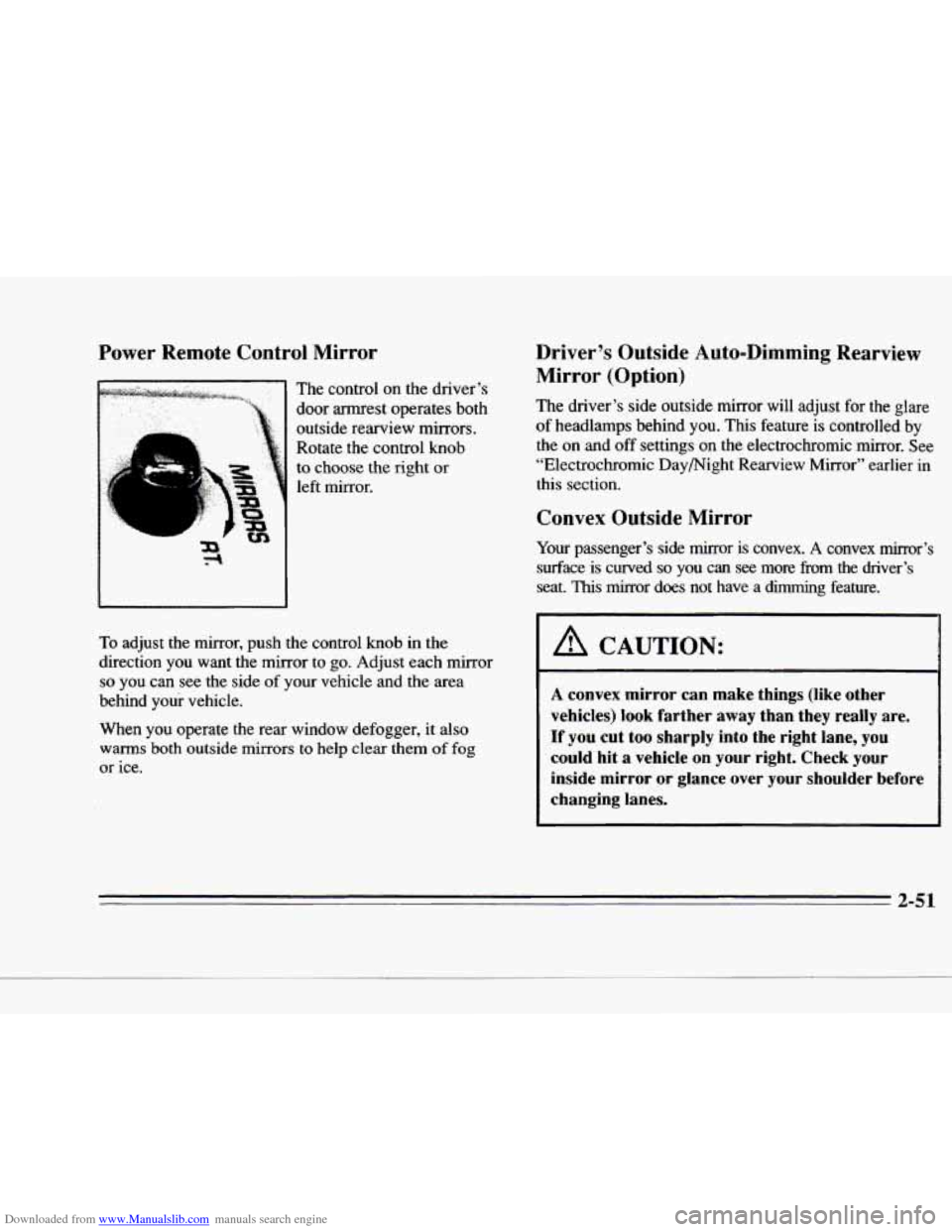
Downloaded from www.Manualslib.com manuals search engine d
Power Remote Control Mirror
The control on the driver’s
door armrest operates both
outside rearview mirrors. Rotate the control
knob
to choose the right or
left mirror.
To adjust the mirror, push the control knob in the
direction you want the mirror to go. Adjust each mirror
so you can see the side of your vehicle and the area
behind your vehicle.
When you operate the rear window defogger, it also
warms both outside mirrors to help clear them
of fog
or ice.
Driver’s Outside Auto-Dimming Rearview Mirror (Option)
The driver’s side outside mirror will adjust for the glare
of headlamps behind you. This feature is controlled
by
the on and off settings on the electrochromic mirror. See
“Electrochromic Daymight Rearview Mirror” earlier in
this section.
Convex Outside Mirror
Your passenger’s side mirror is convex. A convex mirror’s
surface is curved
so you can see more fiom the driver’s
seat.
This mirror does not have a dimming feature.
I A CAUTION:
A convex mirror can make things (like other
vehicles)
look farther away than they really are.
If you cut too sharply into the right lane, you
could hit
a vehicle on your right. Check your
inside mirror or glance over your shoulder before
changing lanes.
c 2-51
Page 197 of 354
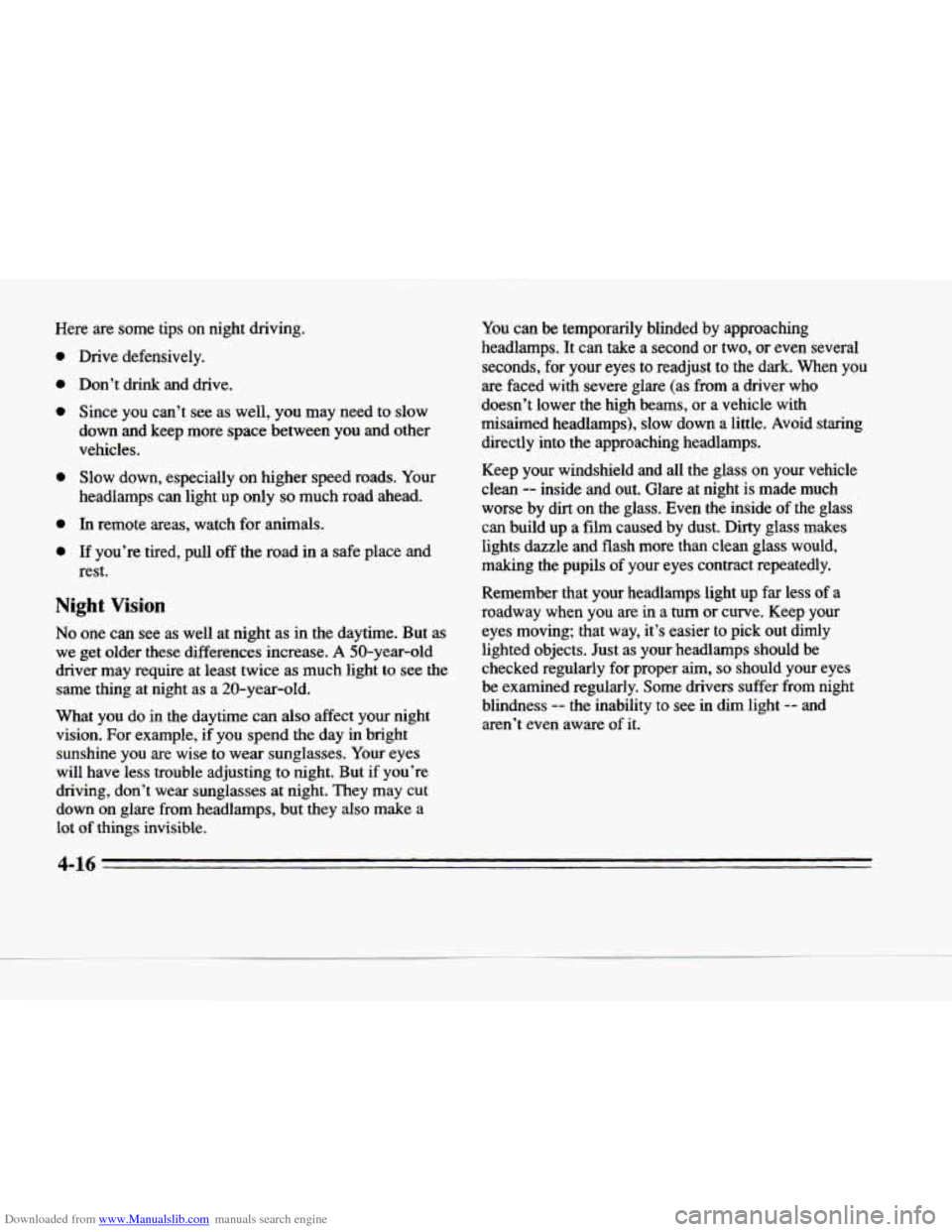
Downloaded from www.Manualslib.com manuals search engine Here are some tips on night driving.
0
e
0
0
0
a
Drive defensively.
Don’t drink and drive.
Since
you can’t see as well, you may need to slow
down and keep more space between you and other
vehicles.
Slow down, especially
on higher speed roads. Your
headlamps can light up only
so much road ahead.
In remote areas, watch for animals.
If you’re tired, pull off the road. in a safe place and
rest.
Night Vision
No one can see as well at night as in the daytime. But as
we get older these differences increase. A 50-year-old
driver may require at least twice as much light to see the
same thing at night as a 20-year-old.
What
you do in the daytime can also affect y6lE night
vision. For example,
if you spend the day in bright
sunshine you
are wise to wear sunglasses. Your eyes
will have less trouble adjusting
to night. But if you’re
driving, don’t wear sunglasses at night. They may cut
down
on glare from headlamps, but they also make a
lot of things invisible. You
can
be temporarily blinded by approaching
headlamps. It can take
a second or two, or even several
seconds, for your eyes to readjust to the dark. When you
are faced with severe glare (as from
a driver who
doesn’t lower the high beams, or a vehicle with
misaimed headlamps), slow down
a little. Avoid staring
directly into the approaching headlamps.
Keep your windshield and all the glass on your vehicle
clean
-- inside and out. Glare at night is made much
worse by dirt on the glass. Even the inside
of the glass
can build up a film caused by dust.
Dirty glass makes
lights dazzle and flash more than clean glass would,
making the pupils
of your eyes contract repeatedly.
Remember that your headlamps light up
far less of a
roadway when you are in a turn or curve. Keep
your
eyes moving; that way, it’s easier to pick out dimly
lighted objects. Just as your headlamps should be
checked regularly for proper aim,
so should your eyes
be examined regularly. Some drivers suffer from night
blindness
-- the inability to see in dim light -- and
aren’t even aware of
it.
4-16